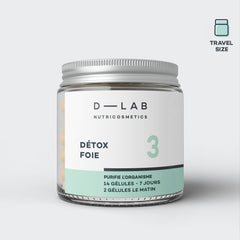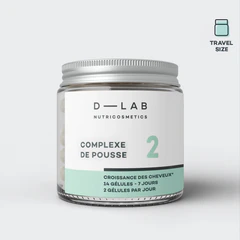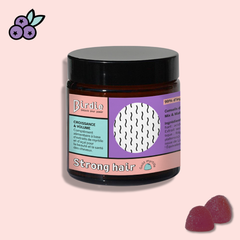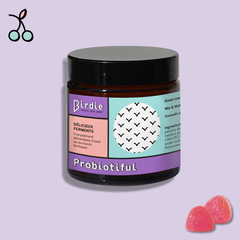Scalp eczema: natural treatments
Dry scalp, itching, red patches and dandruff... You probably suffer from scalp eczema!
Don't panic, in this article, we reveal our advice to find a healthy scalp

However, before treating your scalp, it is important to Identify your type of eczema. There are three types: seborrheic dermatitis, atopic eczema and allergic eczema. It is important to have the advice of a dermatologist before starting any treatment, even a natural one.
Seborrheic eczema
Its causes :
seborrheic dermatitis is the most frequent form eczema. It often dates back to early childhood (cradle cap in infants). In adults, its scalp is dry which causes the appearance of dandruff. An inflammation of the scalp can appear in more severe cases.
It is caused mainly by yeasts of the Malassezia. These fungi proliferate in particular in an oily scalp. It can also be caused by stress, anxiety or fatigue.
Symptoms of this condition can vary from person to person, but the most common signs are red patches, scales and itching. These patches may be oily and yellowish and may appear on the scalpface, ears and torso.
Treatment forseborrheic eczema depends on the severity of the symptoms. In mild cases, anti-dandruff shampoos, moisturizers and ointments can be used to reduce itching and scaling. Topical medications such as steroids and antifungals can also be used to treat more severe symptoms. Oral medications such as antifungals and immunosuppressants may also be prescribed to treat chronic seborrheic eczema.
It is important to take care of the skin when suffering from seborrheic eczema. Avoiding irritants such as scented cosmetics andharsh cleaning products can help prevent flare-ups. Keeping the skin clean and moisturized can also help reduce symptoms.

Atopic eczema
Its causes :
It differs from other types of eczema in that it results in red patches and water blisters. Teenagers and young adults are mainly affected by this type ofeczema. It is usually hereditary and genetic. It is an eczema that is caused by an allergic terrain. In fact, the people concerned by this eczema often suffer from other types of allergies in parallel.
The symptoms ofatopic eczema can vary from person to person, but red patches and itching are the most common symptoms. These patches can develop on any part of the body, but are most common on the arms, legs, face and neck. The patches may also ooze or crust over. The itching can be so intense that they can disrupt sleep and cause anxiety and depression in some people.
There is no cure for atopic eczema, but there are treatments that can help relieve symptoms. Topical creams and ointments can help reduce inflammation and moisturize the skin. Antihistamines can help reduce itching and irritation.
Allergic eczema (also called contact eczema)
Its causes :
Allergic eczema, also called allergic contact dermatitis, is a form of eczema that occurs when the skin comes into contact with an allergenic substance.
Common allergens include metals, chemicals, cosmetics, perfumes, plants and cleaning products. This condition can cause red patches, itching, blistering and inflammation of the skin.
Allergic eczema develops when the immune system overreacts to a foreign substance, causing an allergic reaction. Symptoms can vary from person to person, but red patches, itching and blisters are the most common symptoms. Symptoms may appear immediately after contact with the allergen or may take several days to appear.
Treatment for allergic eczema usually involves avoiding known allergens. If this is not possible, topical creams and ointments can be used to reduce itching and inflammation of the skin. Antihistamines can also be used to reduce itching and irritation.
It is important to take care of the skin when suffering from allergic eczema. Avoiding known irritants and allergens is crucial to preventing flare-ups. Using cotton clothing and avoiding synthetic materials can also help reduce skin irritation. Keeping the skin moisturized by using unscented moisturizers is also important.
Many of the beauty products we use every day contain substances that are harmful to the scalp. These substances are found in hair dyes and especially in shampoos. Here are some examples to avoid: paraphenylenediamine (PPD), sodium lauryl, lauryl sulfate, benzyl benzoate, ammonium sulfate...
So, choose natural, simple and gentle products!

Some natural solutions...
Here are some natural solutions to treat your scalp eczema:
- Use gentle, natural shampoos to avoid using products with too many allergens.
- Avoid very hot water and rinse your hair with lukewarm water so as not to damage the skin.
- Grandma's recipes are your allies! A homemade, easy to make and economical shampoo based on baking soda and vinegar to regulate the natural pH of your hair: Mix a tablespoon of baking soda in a glass of warm water then apply the mixture to your scalp and rinse with water.
- Make natural masks to soothe eczema: a mask with tea tree oil or palmarosa oil for their purifying and anti-fungal properties, a mask with lavender essential oil for its soothing properties, a mask with olive oil, a mask with aloe vera gel or coconut oil...: easy to make and economical!
- Adopt a healthy and balanced diet

To take care of your scalp with D-LAB food supplements
The scalp is a very fragile area that requires our full attention to prevent dandruff, itching and excess sebum. It is essential to maintain a good microcirculation and to cleanse it from the inside by providing very targeted active ingredients.




